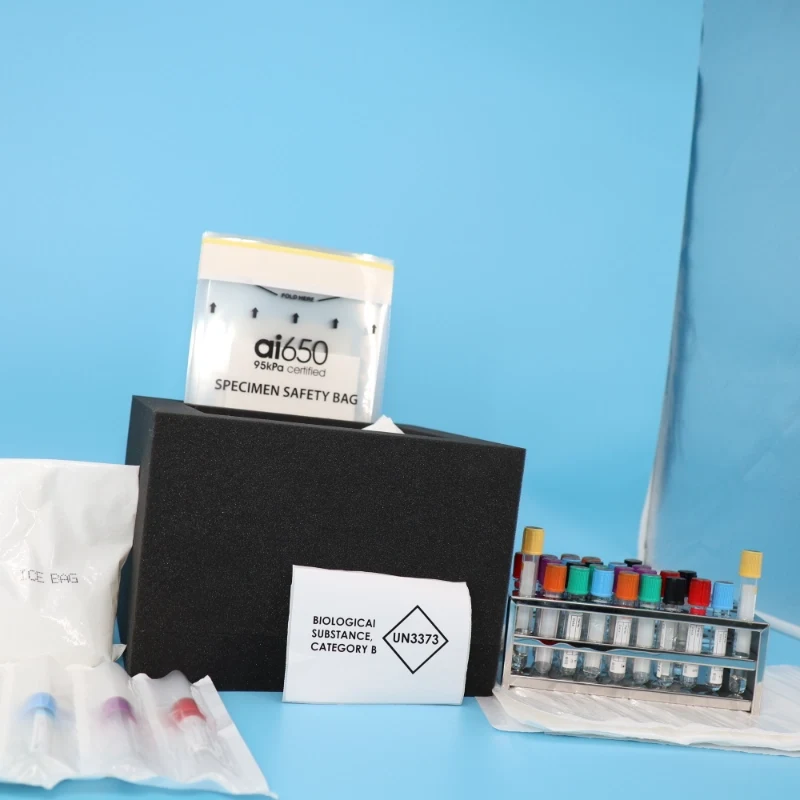How to use 95kpa specimen transport bag
Release time: 2025-03-20
95kPa specimen transport bags are used in the fields of medicine, scientific research and public health, especially in the transportation of samples involving infectious pathogens, to ensure sample safety, prevent leakage and cross contamination. 95kpa bags meet international transportation standards and can ensure that specimens are effectively isolated and protected during transportation.
Definition and Function
The 95kPa specimen transport bag can withstand a standard of at least 95 kilopascals (kPa) of air pressure, which means that during transportation, it can withstand changes in external pressure without leaking. This design is to meet the requirements of specimens in high-pressure environments such as air transportation, and prevent specimens from leaking and contaminating the environment.
Composition and structure
Outer bag: generally made of high-strength, pressure-resistant plastic or composite materials to ensure the overall sealing and pressure resistance of the bag.
Sealing strip: ensure that the bag cannot be easily opened after sealing to prevent sample leakage.
Absorbent pad: an absorbent pad is placed inside the bag to absorb possible liquid leakage to ensure that when the transport sample container is broken or leaking, the liquid will not contaminate the external environment.
External marking area: there is an area for labeling and recording transportation information to facilitate staff to mark.
Instructions
Step 1: Preparation
Check the bag: Check the integrity of the 95kPa specimen transport bag before use to ensure that there is no damage, tearing or other damage that may affect the seal. Make sure the absorbent pad is intact and the sealing strip is intact.
Prepare the specimen container: According to the transportation requirements, select a suitable specimen container (such as a test tube, sampling tube, etc.) to ensure that the container has a good seal. The sample information needs to be clearly marked on the container.
Step 2: Load the specimen
Place the specimen container: Place the sealed and clearly labeled specimen container inside the 95kPa transport bag. Make sure the absorbent pad at the bottom of the transport bag is stable and not loose to prevent the specimen container from being damaged during transportation.
Check the seal: Check whether the container is leaking. If it is a liquid sample, consider using additional leak-proof sealing measures.
Step 3: Sealing and sealing
Sealing: Close the mouth of the transport bag and use the sealing strip or sealing tape on the bag to ensure that the bag mouth is completely sealed. A loose seal may cause leakage risk.
Double packaging (if necessary): For increased safety, in some cases, it is necessary to put the 95kPa specimen transport bag into an outer packaging bag or box, especially in the case of long-distance transportation or more dangerous specimens, double packaging can further ensure safety.
Step 4: Labeling and Recording
Label information: Clearly mark the type of sample, sampling date, shipping destination, recipient, and other necessary shipping information on the outside of the shipping bag. In addition, a “biohazard” label should be affixed to the packaging so that staff can identify and take necessary precautions.
Additional documents: Additional shipping documents may also be required based on regulatory requirements, such as sample lists, shipping permits, etc.
Step 5: Transport
Ensure stability: Avoid severe vibration or external force during transportation, especially for fragile specimen containers. Use shockproof packaging materials or place them firmly to ensure that the specimens do not move.
Temperature control requirements: Depending on the type of specimen, it may be necessary to control the temperature during transportation (such as ice packs or low-temperature transportation). Before transportation, confirm whether the temperature control requirements are met.
Precautions
Strictly comply with regulations: The use of 95kPa biological specimen transport bags must comply with the relevant laws and regulations of the country or region, such as the “Biological Sample Transport Regulations” and “Dangerous Goods Transport Regulations”.
Avoid high temperature and humidity: High temperature or humid environment may affect the sealing of the specimen bag. Therefore, extreme temperature and humidity conditions should be avoided during transportation.
Regular inspection and maintenance: Regularly check the use of 95kPa specimen transport bags and other transportation equipment to ensure that they are in the best condition before transportation.
The correct use of 95kPa specimen transport bags can effectively prevent sample leakage and cross contamination, ensure the safety of personnel during transportation and the integrity of samples.


